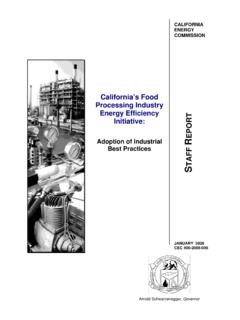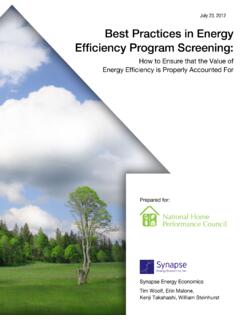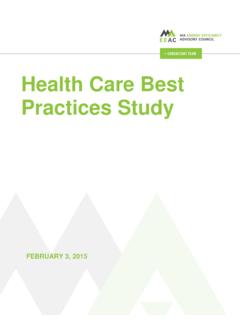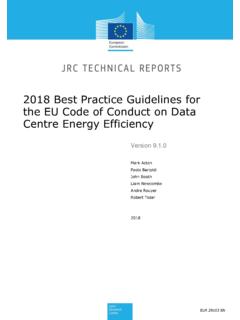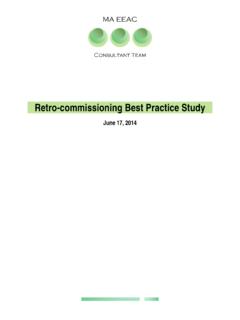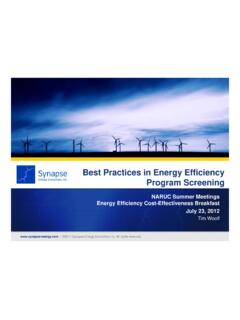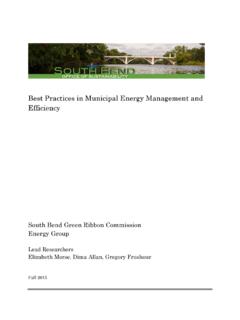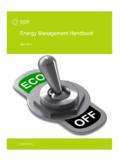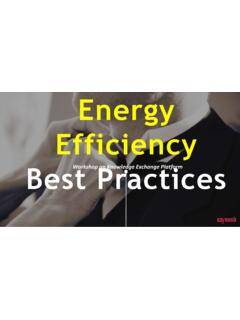Transcription of COMMUNITY ENERGY MANAGEMENT - BEST …
1 COMMUNITY ENERGY MANAGEMENT - best practices COMMUNITY ENERGY MANAGEMENT best practices Index Program Overview best Practice One: COMMUNITY Plans and Public Outreach ENERGY Plan Public Participation best Practice Two: Zoning Regulations Zoning Regulations best Practice Three: Project Review Process Project Review Policy and Procedures Guide to ENERGY efficiency and Renewable ENERGY Projects best Practice Four: Recruitment and Education Recruitment and Orientation Education and Training best Practice Five: Clean ENERGY Communities Clean ENERGY Sites COMMUNITY ENERGY MANAGEMENT best Practice Six: COMMUNITY Prosperity Economic Development Strategy Marketing and Promotion Glossary Acknowledgements COMMUNITY ENERGY MANAGEMENT - best practices Program Overview Local governments across Michigan struggle with economic constraints and seek tools to secure their financial health and identify sources of stable on-going funding for their critical services.
2 ENERGY costs for the operation of municipal buildings and infrastructure are a rising expense for communities. Fortunately, ENERGY costs also represent one of the easiest places where cost savings can be realized. However, local governments frequently lack the technical expertise and staff capacity to pursue those savings. Even when staff members are interested in pursuing ENERGY savings, determining where the necessary information is and how to prioritize improvements is an ongoing challenge. This is where the services of a COMMUNITY ENERGY Manager (CEM) familiar with municipal operations and political processes, financing options, and moving projects through local government processes, can provide valuable services and produce measurable savings. This checklist is a self-evaluation tool for communities seeking to take control of their local ENERGY use and generation through the development of a COMMUNITY ENERGY MANAGEMENT program and provides a framework the COMMUNITY ENERGY Manager can use for discussing ENERGY issues with the COMMUNITY and adopt formal ENERGY goals and policies.
3 The required best practices include flexible approaches and ideas for extra-mile efforts that may be appropriate in some communities. The accompanying Toolkit provides additional narrative on the best practices , to assist communities in fulfilling the criteria. Additionally, a sample Position Description for a COMMUNITY ENERGY Manager (on-staff or coordinated through a consultant) and a step-by-step Strategy for achieving the best practices are also provided. The best practices are based on six pillars, and align with the Redevelopment Ready Communities program. The CEM best practices address ENERGY efficiency , renewable ENERGY , and ENERGY -related developments, and are supplemented by the solar ENERGY best practices developed concurrently under a separate grant. While there is an implied chronological sequence to the best practices , what is most critical is that the COMMUNITY embraces their collective responsibility and have a plan with goals to guide and regularly monitor the effectiveness of their efforts.
4 Early planning, at the beginning of the COMMUNITY discussion, should include following the criteria set out in these best practices and broadening the COMMUNITY s vision of areas where they can impact local ENERGY . COMMUNITY ENERGY MANAGEMENT is a new approach to local planning that prioritizes ENERGY efficiency and renewable ENERGY along with the businesses that support them. COMMUNITY ENERGY MANAGEMENT addresses all ENERGY use within a municipality (city, village, township, county) and strives to meet their local economic, environmental, and social goals. ENERGY sectors and opportunities for efficiency in your COMMUNITY include: buildings (residential, commercial), industry, municipal infrastructure (street & traffic lights, services, water MANAGEMENT , wastewater MANAGEMENT , solid waste MANAGEMENT ), transportation (commuter, service, delivery), and utilities (resource extraction, resource delivery, power generation, transmission).
5 Renewable ENERGY resources include: solar, wind, biomass, and geothermal. In addition to meeting local needs, COMMUNITY ENERGY MANAGEMENT aligns directly with policies, regulations, and goals in Michigan and at the federal level: COMMUNITY ENERGY MANAGEMENT - best practices Governor Snyder s plan for Michigan s bright ENERGY future with new affordable, reliable and adaptable ENERGY that protects Michigan s environment for generations to come. His goal is to replace 30-40% of our ENERGY needs through the elimination of wasted ENERGY and shift to cleaner sources in 10 years, by 2025. ( ,,7-277-57577_57657-349790--, ) The Department of ENERGY s Strategic Plan includes catalyzing the timely, material and efficient transformation of the nation s ENERGY system and securing leadership in clean ENERGY technologies. ( ) DOE s Office of ENERGY efficiency and Renewable ENERGY (EERE) leads efforts to develop and deliver market-driven solutions for ENERGY -saving homes, buildings, and manufacturing; sustainable transportation; and renewable electricity generation.
6 ( ) EERE supports states and cities with programs and initiatives, technical assistance and tools, information, and education. ( ) Environmental Protection Agency Clean Power Plan ( ) Clean Power Plan for Existing Power Plants ( #federal-plan) Clean Power Plan: At A Glance Michigan factsheet ( ) Local communities are an integral part of meeting Michigan and federal goals for our new clean ENERGY future. Opportunities for ENERGY efficiency and renewable ENERGY are abundant in every COMMUNITY . COMMUNITY ENERGY MANAGEMENT - best practices best Practice One: COMMUNITY Plans and Public Outreach ENERGY Plan Policy guidance for COMMUNITY ENERGY MANAGEMENT may occur through a variety of plans, such as a special section in the Master Plan or a separately adopted resiliency or ENERGY plan. This policy supports the advancement of local clean ENERGY through renewable ENERGY generation and ENERGY efficiency .
7 It also provides the basis for related land use regulation, capital investment, program development and economic strategies. The planning effort and resulting guiding documents can help maximize ENERGY savings in ENERGY efficiency and renewable ENERGY projects and ensure that the work done fits in with the COMMUNITY s values and ENERGY goals. Evaluation Criteria Expectations The governing body has adopted or updated ENERGY policy guidance as a part of their Master Plan in the past 5 years. The ENERGY policy guidance clearly expresses support for local clean ENERGY using common planning document language. The master plan includes specific standards and requirements related to ENERGY efficiency upgrades in municipal buildings and renewable ENERGY installations on municipally owned property and/or A separate ENERGY MANAGEMENT plan has been adopted that is founded on baseline ENERGY consumption analysis performed on municipally owned property, capital improvement plans, current governmental initiatives related to ENERGY efficiency or renewable ENERGY generation, a land use master plan, any existing sustainability planning or ENERGY MANAGEMENT plans, and relevant building codes.
8 The ENERGY policy guidance is accessible online. The Master Plan identifies strategies for increasing clean ENERGY in the COMMUNITY , including municipal ENERGY MANAGEMENT . The ENERGY strategy/policy identifies priority clean ENERGY actions, projects and programs, in the COMMUNITY . The ENERGY strategy/policy contains goals with implementation steps and tools for advancing clean ENERGY in the COMMUNITY The ENERGY strategy/policy includes a targets with a timeline identifying responsible parties and benchmarks. Progress on the ENERGY strategy/policy implementation, barriers, and accomplishments toward the goals and COMMUNITY ENERGY MANAGEMENT - best practices Evaluation Criteria Expectations targets is annually reported to the governing body and to the COMMUNITY . For municipal buildings/facilities, the master plan (or ENERGY MANAGEMENT plan) includes a summary of current ENERGY consumption through ENERGY Star Portfolio Manager, identifies sequenced projects that are grouped by short-term, medium-term, and long-term strategies for increasing ENERGY efficiency or renewable ENERGY generation, identifies underperforming buildings that are targeted for ASHRAE level 2 audits or targeted ENERGY studies, and describes mechanisms for institutionalizing ENERGY efficiency and renewable ENERGY decision making.
9 The governing body has adopted a capital improvement plan (CIP) that includes support for the clean ENERGY strategies identified in the Master Plan. The CIP includes investments that incorporate prioritized clean ENERGY projects, including specific opportunities for ENERGY efficiency upgrades or preparing facilities for renewable ENERGY installations. The CIP includes narrative descriptions of projects, recommended timing, and possible funding mechanisms. The CIP coordinates various clean ENERGY projects to minimize costs and impacts while maximizing future savings and benefits, where feasible. The ENERGY strategy is integrated into other components of the Master Plan, such as a sustainability or climate action plan, downtown development plan, corridor plans, and/or other sub-area plans, if applicable. The applicable plans outline specific opportunities to reduce ENERGY consumption and/or generate renewable ENERGY that are consistent with their respective goals.
10 COMMUNITY ENERGY MANAGEMENT - best practices best Practice One: COMMUNITY Plans and Public Outreach Public Participation Public participation is critical in the initial development of the ENERGY policy guidance and ongoing as ENERGY programs are developed. The ENERGY policy needs to reflect the culture, assets and aspirations of the residents and local businesses. COMMUNITY ENERGY MANAGEMENT overlaps with and is affected by neighboring jurisdictions, regional ENERGY industry businesses, schools, utility, area non-profits, county and state in addition to local residents, businesses, and developers. Evaluation Criteria Expectations The COMMUNITY has a public participation plan that engages a diverse set of stakeholders. The ENERGY policy guidance identifies key stakeholders, including those not normally at the visioning table, such as.










